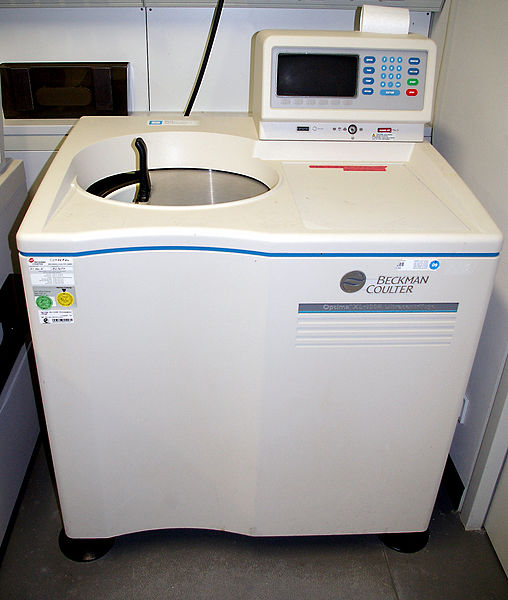An ultracentrifuge is a centrifuge optimized for spinning a rotor at very high speeds, capable of generating acceleration as high as 1 000 000 g. There are two kinds of ultracentrifuges, the preparative and the analytical ultracentrifuge. Both classes of instruments find important uses in molecular biology, biochemistry, and polymer science.
A standard ultracentrifuge by manufacturer Beckman Coulter
Comparing Serial Numbers 1 and 1000 of Spinco's Model E Analytical Ultracentrifuge, 1965
A centrifuge is a device that uses centrifugal force to subject a specimen to a specified constant force, for example to separate various components of a fluid. This is achieved by spinning the fluid at high speed within a container, thereby separating fluids of different densities or liquids from solids. It works by causing denser substances and particles to move outward in the radial direction. At the same time, objects that are less dense are displaced and moved to the centre. In a laboratory centrifuge that uses sample tubes, the radial acceleration causes denser particles to settle to the bottom of the tube, while low-density substances rise to the top. A centrifuge can be a very effective filter that separates contaminants from the main body of fluid.

A laboratory tabletop centrifuge. The rotating unit, called the rotor, has fixed holes drilled at an angle (to the vertical), visible inside the smooth silver rim. Sample tubes are placed in these slots and the motor is spun. As the centrifugal force is in the horizontal plane and the tubes are fixed at an angle, the particles have to travel only a short distance before they hit the wall of the tube and then slide down to the bottom. These angle rotors are very popular in the lab for routine use.
A 19th-century hand-cranked laboratory centrifuge.
Samples placed in a small laboratory centrifuge
Whole blood is often separated, using a centrifuge, into components for storage and transport






